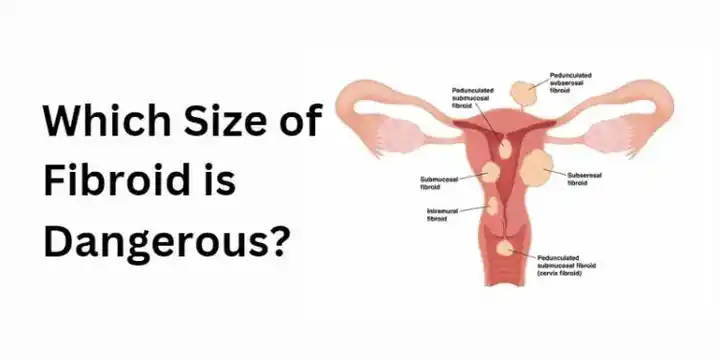While most fibroids don’t cause major issues, some of the larger ones can cause trouble. We’re talking about heavy, drawn-out periods, pain, and pressure. So, which size of fibroid is dangerous? We’ll walk through the sizes that matter and help you know the symptoms and the treatment options available.
What is Fibroid?
Fibroids are non-cancerous growths in the uterus. They are made up of muscle and fibrous tissue. Fibroids can range from the size of a pea to as large as a cantaloupe. Most women have no symptoms and don’t even know they have fibroids. But for some, fibroids can cause heavy bleeding, pain, or problems getting pregnant.
Understanding Fibroid Sizes
Fibroids come in different sizes, ranging from extremely small to medium to large.
Small fibroids, less than 1- 5 cm in diameter, usually don’t cause problems or symptoms. They are often found during routine pelvic exams and usually don’t require treatment other than monitoring to ensure they don’t grow rapidly.
Medium-sized fibroids, ranging from 5 to 10 cm, may cause some pelvic pain or pressure, backache, or changes in menstruation like heavier bleeding or cramping. Treatment options at this stage include medication to help shrink the fibroids or procedures like myomectomy.
Large fibroids, greater than 10 cm in size, can cause significant symptoms like anemia from heavy bleeding, pelvic pain, cramping, and bladder or bowel problems. These often require more aggressive treatment to provide relief from symptoms and prevent further growth. Treatment options include myomectomy, endometrial ablation, uterine artery embolization, and, in severe cases, hysterectomy may be recommended.
The size and location of your fibroids, as well as your symptoms, will help determine the best course of treatment. The good news is there are many options for managing fibroids without having to resort to a hysterectomy. Talk to your doctor about developing a customized treatment plan based on your unique condition and needs.
Which Size of Fibroid is Dangerous?
As a general rule, the larger the fibroid, the more likely it is to cause problems. Fibroids that are smaller than a grapefruit are usually not dangerous and rarely cause symptoms. Fibroids exceeding 5 centimeters (50 mm) are considered potentially dangerous. However, larger fibroids, especially those over 10 cm in diameter, can potentially lead to serious complications.
These oversized fibroids may cause pressure on the bladder or rectum, leading to frequent urination or constipation. They can also cause lower back pain or pelvic pain that interferes with sexual intercourse. Large fibroids may lead to heavy menstrual bleeding and anemia. In some cases, they may cause infertility or increase the risk of miscarriage.
Very large fibroids, especially those over 20 cm, require close monitoring by your doctor. They can potentially cause acute pain, rapid growth, or twist the uterus. Although rare, they may lead to a medical emergency like excessive bleeding. The safest course of action is to consider surgically removing especially large fibroids before they cause dangerous complications.
The location and type of fibroid play a role in determining if it requires treatment. Submucosal fibroids, those located just under the uterine lining, and pedunculated fibroids, those attached to the uterus by a stalk, tend to cause more issues even when small in size. Intramural fibroids, those within the uterine wall, and subserosal fibroids, those protruding from the outer uterine wall, are usually less problematic unless quite large.
Close monitoring or removal of larger fibroids may help improve your quality of life and reproductive health. The good news is there are many treatment options available for fibroids of all sizes. Discussing the pros and cons of each treatment with your doctor can help determine the best approach based on your symptoms and fertility goals.
Does the Number of Fibroids Make a Difference?
The number of fibroids you have can impact your symptoms and treatment options. Having multiple fibroids means there are more masses taking up space in the uterus, possibly leading to heavier bleeding, pelvic pain, and pressure. However, some women with many fibroids experience no problems at all.
Conversely, a single fibroid in a critical location, like near the fallopian tubes or cervix, may cause significant issues. The position and size of your fibroids, not just the number present, are most important in determining if they require treatment and which options may provide the best results.
While multiple fibroids increase the risk of new fibroids forming after treatment, don’t let the number alone deter you from exploring your options. The good news is that most treatments, like medications, hormone therapy, uterine fibroid embolization, and focused ultrasound, work for women with any number of fibroids. If your symptoms call for surgical removal, a skilled doctor can extract even multiple fibroids while preserving your fertility.
The bottom line is that the number of fibroids is not as important as their size, location, and the severity of your symptoms. An experienced doctor can evaluate your unique situation, risks, and needs to recommend an appropriate course of treatment, regardless of how many fibroids are present.
Symptoms of Dangerously Large Fibroids
If your fibroids grow larger than a grapefruit, they can potentially become dangerous. Some warning signs to watch out for include:
Heavy bleeding causes anemia. Losing too much blood during your period can lead to anemia. See your doctor right away if your periods become very heavy or last more than 7-10 days.
Severe pain or pressure. Large fibroids can press on nerves and organs, causing pain, discomfort, or difficulty with bowel movements or urination. Sharp pains in the pelvis can also be a sign that a fibroid has become twisted or degenerating.
Infertility or miscarriage. Fibroids that distort the shape of the uterus or block the fallopian tubes can make it difficult to get pregnant or carry a pregnancy to term. See your doctor if you’ve been trying to conceive for 6-12 months without success.
Rapid growth. Fibroids that quickly become larger, especially during or after menopause, need to be monitored closely. Although rare, some fibroids can be cancerous. Your doctor may order imaging tests to determine if rapidly growing fibroids require surgery.
Looking pregnant. A large fibroid tumor can make your abdomen swell, and clothes feel tight. If your belly has a firm, irregular mass, especially on one side, it could indicate a large fibroid or several fibroids clumped together.
Constipation or difficulty urinating. Large fibroids can press against your colon, bladder, or ureters and cause changes in bowel or bladder habits. See your doctor right away if you have trouble passing stool or experience frequent urination, difficulty urinating, or cloudy urine.
Nausea or vomiting. In some cases, large or degenerating fibroids can put pressure on the intestines or other abdominal organs, resulting in nausea, vomiting, and loss of appetite. These symptoms require immediate medical attention.
Dizziness or fatigue. Severe anemia from heavy bleeding can cause fatigue, shortness of breath, chest pain, dizziness, or lightheadedness. See your doctor right away for blood work and possible iron supplements or blood transfusion.
Factors That Influence Fibroid Size
The size of fibroids can vary greatly among women and over time. Several factors contribute to fibroid growth:
Age and hormones. Fibroids tend to grow rapidly during the reproductive years, especially during pregnancy, when estrogen levels are high. They often shrink after menopause when estrogen levels decline.
Genetics. Having a family history of fibroids increases your risk of developing them. Fibroids that run in families also tend to be larger.
Pregnancy. Fibroids typically increase in size during pregnancy when hormone levels are high and shrink again after delivery. Multiple pregnancies further increase the risk of fibroid growth.
Obesity. Excess body weight and fat cells produce extra estrogen, fueling fibroid growth. Losing weight can help slow or prevent fibroids from enlarging.
Stress. Some research links chronic stress and anxiety to changes in hormone levels that may promote fibroid growth. Managing stress through exercise, meditation, or counseling may help.
Diet. A diet high in red meat and low in green vegetables, fruit, and dairy may increase the risk of fibroids. Eating an anti-inflammatory diet with these foods may help prevent growth.
Early menstruation. Having your first period before age 10 is a risk factor for fibroids and may lead to faster growth....Read Full Article [Click Here>]
Hormone imbalance. High estrogen levels relative to progesterone can trigger abnormal growths like fibroids. Balancing hormones through medication or lifestyle changes may help shrink fibroids.
In summary, age, genetics, hormones, pregnancy, weight, diet, stress, and menstruation history can all influence how quickly your fibroids may grow or spread. Making certain lifestyle changes may help slow, stop, or even shrink troublesome fibroids.
Complications Caused by Different Fibroid Sizes
The size of your fibroids can lead to complications if left untreated. Small fibroids, around the size of a grape, often cause no symptoms and are usually harmless. However, larger fibroids can lead to the following problems:
Heavy menstrual bleeding – Fibroids can increase the surface area of the uterine lining, leading to flooding during your period. This can cause anemia from blood loss.
Pain – As fibroids grow, they can put pressure on surrounding organs like the bladder and bowels. This may lead to painful cramping, back pain, or pain during sex.
Infertility – Fibroids that distort the shape of the uterine cavity can block the fallopian tubes or prevent a fertilized egg from implanting, making it difficult to get pregnant.
Miscarriage – Similarly, fibroids that encroach on the uterine cavity can increase the risk of miscarriage during the first and second trimesters of pregnancy.
Premature birth – Fibroids may lead to preterm labor and delivery before 37 weeks of pregnancy. They can also cause the baby to not grow properly in the womb.
Bloating – Large fibroids can cause a swollen belly that makes you look pregnant. This is due to fluid buildup and the sheer mass of the fibroids.
Anemia – Heavy bleeding from fibroids can deplete your body of iron, leading to fatigue, shortness of breath, and pale skin. Iron supplements or blood transfusions may be needed in severe cases.
Urinary problems – Fibroids that press on the bladder can lead to frequent urination, difficulty urinating, or the inability to empty your bladder completely. In rare cases, they may even obstruct the ureters.
If your fibroids start to cause bothersome symptoms or complications, it’s best to discuss treatment options with your doctor to improve your quality of life and long-term health. The good news is there are many minimally invasive procedures available to provide relief from even the largest of fibroids.
How to Reduce the Danger of Fibroid Sizes?
These are some of the ways to reduce the dancers of fibroid:
Diet
The foods you eat can influence your hormone levels and the growth of fibroids. Focus on organic foods, especially fruits and vegetables. Some good options include:
Cruciferous veggies like broccoli and cabbage contain compounds that may help balance hormones.
Flax and chia seeds provide fiber and alpha-linolenic acid, an omega-3 fat that aids hormone regulation.
Turmeric and ginger have anti-inflammatory effects and may slow fibroid growth. Add them to meals or make tea.
Exercise
Exercise improves circulation, helps manage weight, and releases feel-good hormones that combat stress. All of these benefits may help reduce fibroid risk and slow growth. Aim for 30 to 60 minutes of moderate activity most days. Walking, yoga, and strength training are excellent options.
Manage Stress
Chronic stress can negatively impact your hormone levels and overall health. Try relaxation techniques like meditation, deep breathing, journaling, or yoga. Limit stressors when you can and take occasional breaks to recharge.
Sleep
Lack of sleep disrupts many hormones and biological processes in the body. Most adults need 7 to 9 hours of sleep per night to function optimally. Develop a relaxing bedtime routine, avoid screen time and caffeine, and exercise close to bedtime.
Other solutions include Losing excess pounds and managing stress through meditation, yoga, or journaling. Limiting alcohol and avoiding caffeine can aggravate fibroid symptoms. Castor oil packs and heat were applied to the abdomen. Some women find this helps relieve symptoms and may reduce fibroid size.
Talk to your doctor about natural remedies and the best options based on your fibroid size and symptoms. While alternative therapies may provide relief for some women, they do not work for everyone and should not replace medical treatment. Close monitoring by your physician is still important.
Treatment Options for Large Fibroids
When fibroids become quite large, they can cause discomfort, pain, and other issues. At this point, you’ll want to consider treatment to provide relief. Here are some options to discuss with your doctor:
Medications like hormonal birth control or GnRH agonists may help shrink large fibroids or reduce symptoms. These drugs decrease estrogen levels, causing fibroids to get smaller. Side effects can include hot flashes, mood changes, and bone loss.
MRI-guided focused ultrasound (MRgFUS) uses high-energy ultrasound waves to generate heat and destroy fibroid tissue. It is also non-invasive but may require repeated treatments. This non-invasive treatment is for fibroids that cause moderate to severe symptoms. You may need occasional “touch-up” treatments as fibroids can grow back.
Uterine artery embolization cuts off blood flow to fibroids, causing them to shrink and die. A radiologist inserts a catheter into the uterine arteries and injects particles to block blood flow. This minimally invasive procedure relieves symptoms for most women.
Myomectomy surgically removes fibroids while preserving the uterus. For large or numerous fibroids, an open abdominal procedure may be required. A minimally invasive laparoscopic or robotic approach has a faster recovery but may not remove all fibroid tissues. Fibroids can regrow over time.
Endometrial ablation destroys the uterine lining, reducing menstrual bleeding and the size of some submucous fibroids. This outpatient procedure uses heat, cold, microwaves, or other means to ablate the endometrium. It may need to be repeated for the best results.
Hysterectomy removes the entire uterus, permanently eliminating fibroids and symptoms. This major surgery has a long recovery but provides a definitive solution. The ovaries may or may not be removed depending on your age and health needs. Vaginal, laparoscopic, and abdominal approaches are available.
In summary, for significantly enlarged fibroids causing problems, you have several good options to discuss with your doctor to determine the best treatment for your specific situation. The choice often comes down to your desire to retain fertility and preference for a particular approach.
Conclusion
The bottom line is that for most women, small to medium-sized fibroids do not usually pose a health risk and can often be managed with regular monitoring. However, if your fibroids are causing significant symptoms or growing rapidly, it’s best to talk to your doctor about potential treatment options to avoid future complications, regardless of their size. Every woman’s situation is different, so find a doctor you trust and work together to determine the best plan for you. Together, you can determine if it’s a cause for concern or if you can be left alone. Listen to your body, too.





